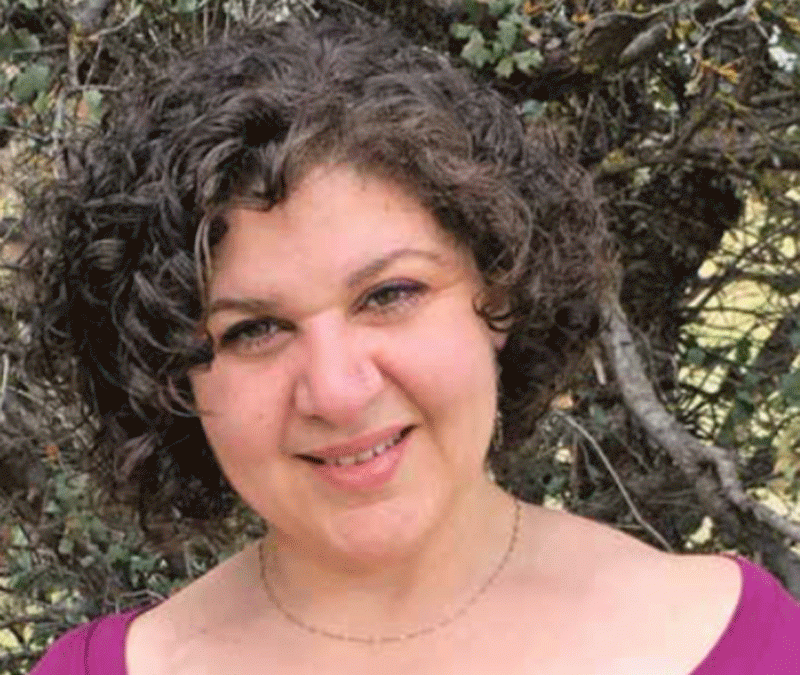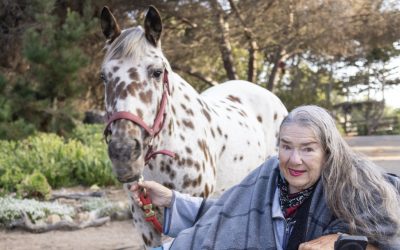Lauren Bell describes herself as someone who isn’t afraid to blaze new trails. In fact, she prides herself on the ability to do so.
“I am on the cutting edge of what is going to happen,” said Bell, emPower’s first female energy coach. “We have to transition (to more sustainable living). It’s a requirement. It’s not a matter of if, it’s a matter of when. Like I said, I am the one to cut the new trail, and I will go through with a machete and really cut it out.”
Bell, 37, has carved new trails through her education choices — she helped create Cal Poly’s environmental science degree — as well as her career path. Not only is the Santa Monica native emPower’s first female energy coach, Bell is also a self-proclaimed earth angel/house doctor.
“Ultimately, when it all really boils down to it, I absolutely am an environmentalist,” Bell said. “I fully advocate for environmental issues. When you change something over here, it’s going to change something else that maybe you don’t think is connected but it really is. It’s the same thing with homes.”
“I am on the cutting edge of what is going to happen,” said Bell, emPower’s first female energy coach. “We have to transition (to more sustainable living). It’s a requirement. It’s not a matter of if, it’s a matter of when. Like I said, I am the one to cut the new trail, and I will go through with a machete and really cut it out.”
Bell, 37, has carved new trails through her education choices — she helped create Cal Poly’s environmental science degree — as well as her career path. Not only is the Santa Monica native emPower’s first female energy coach, Bell is also a self-proclaimed earth angel/house doctor.
“Ultimately, when it all really boils down to it, I absolutely am an environmentalist,” Bell said. “I fully advocate for environmental issues. When you change something over here, it’s going to change something else that maybe you don’t think is connected but it really is. It’s the same thing with homes.”
Bell believes homes should be viewed with a whole-house approach to energy efficiency where all systems in a residence are working together properly, resulting in a more efficient and comfortable living space, something she hopes to change through her work.
“Our homes are not healthy,” Bell said. “ ey were not built supportort the health and vitality of the family. ey were just built to shelter us from the elements and they don’t even do that good of a job of it. I like to think of myself as a house doctor.”
In her role with emPower, Bell is able to make house calls so to speak through visits to homes in San Luis Obispo, Santa Barbara and Ventura counties where she searches for energy efficiency issues that left unchecked can increase an individual’s energy bills or affect their indoor comfort and safety.
During the free site visits, Bell tours a client’s home to inspect the residence’s furnace, water heater and attic access. If there’s a crawl space, she also examines that area, too.
“I go in to poke around all those spaces,” she said. “It’s funny because people say, “Are you really going to go in there (the crawl space or attic)?’ I go in there.”
Bell is looking for everything from appliances that haven’t been con- nected properly to outdated gas lines, asbestos and leaking valves to wall furnaces that are working too hard, all of which can lead to making a person’s home unhealthy at the end of the day.
“There’s a population of people who get really sick from their homes,” she said. “And while most people are not that sensitive, over time that accumulation, sleeping in it, working in it, living in it, of course, it’s just not healthy.”
After her initial inspection, Bell o ers information and tips to the individuals she works with to address the problems she may nd at their residences and helps to connect them with specially trained and certi ed contractors, utility incentives and low-interest financing to get the issues corrected.
Bell grew up playing outside in nature and didn’t watch television as a youth. Nature videos were her form of digital entertainment. She joked that when kids at school were talking about the popular televi- sion program “In Living Color,” she was clueless. What she wasn’t clueless about was knowing what she wanted to do when she grew up — have a career that helped sustain the earth.
“I was raised on nature videos,” Bell explained. “ at was my only form of TV. I would do these little reports on bees and water for my mom, just for fun, based on videos that I watched. I remember very clearly doing these reports. I learned that the majority of human population lives along coastlines, within 10 miles of a coastline. So I knew … that’s where I wanted to work and all of the things that go along with that — plant, animals and people. When I was real young that’s kind of where my head was already and it has somehow mani- fested into a career.”
Bell graduated from Cal Poly in 2009, the rst in her family to earn a bachelor’s degree or even nish high school. She is also a Morro Bay High School graduate. It was her time at Cal Poly that led to the school developing its environmental science curriculum, another trail she helped blaze.
“Our homes are not healthy,” Bell said. “ ey were not built supportort the health and vitality of the family. ey were just built to shelter us from the elements and they don’t even do that good of a job of it. I like to think of myself as a house doctor.”
In her role with emPower, Bell is able to make house calls so to speak through visits to homes in San Luis Obispo, Santa Barbara and Ventura counties where she searches for energy efficiency issues that left unchecked can increase an individual’s energy bills or affect their indoor comfort and safety.
During the free site visits, Bell tours a client’s home to inspect the residence’s furnace, water heater and attic access. If there’s a crawl space, she also examines that area, too.
“I go in to poke around all those spaces,” she said. “It’s funny because people say, “Are you really going to go in there (the crawl space or attic)?’ I go in there.”
Bell is looking for everything from appliances that haven’t been con- nected properly to outdated gas lines, asbestos and leaking valves to wall furnaces that are working too hard, all of which can lead to making a person’s home unhealthy at the end of the day.
“There’s a population of people who get really sick from their homes,” she said. “And while most people are not that sensitive, over time that accumulation, sleeping in it, working in it, living in it, of course, it’s just not healthy.”
After her initial inspection, Bell o ers information and tips to the individuals she works with to address the problems she may nd at their residences and helps to connect them with specially trained and certi ed contractors, utility incentives and low-interest financing to get the issues corrected.
Bell grew up playing outside in nature and didn’t watch television as a youth. Nature videos were her form of digital entertainment. She joked that when kids at school were talking about the popular televi- sion program “In Living Color,” she was clueless. What she wasn’t clueless about was knowing what she wanted to do when she grew up — have a career that helped sustain the earth.
“I was raised on nature videos,” Bell explained. “ at was my only form of TV. I would do these little reports on bees and water for my mom, just for fun, based on videos that I watched. I remember very clearly doing these reports. I learned that the majority of human population lives along coastlines, within 10 miles of a coastline. So I knew … that’s where I wanted to work and all of the things that go along with that — plant, animals and people. When I was real young that’s kind of where my head was already and it has somehow mani- fested into a career.”
Bell graduated from Cal Poly in 2009, the rst in her family to earn a bachelor’s degree or even nish high school. She is also a Morro Bay High School graduate. It was her time at Cal Poly that led to the school developing its environmental science curriculum, another trail she helped blaze.
She explained that when she transferred to the university in 2006, her counselors at community college told her she should major in social science to meet her career goals. But when she got to Cal Poly, the boxes didn’t quite t. After speaking to the department chair, she was told to hand-pick her classes and write an essay prior to graduating.
At that time, Bell was among a handful of other students — architecture, city and regional planning and biology students — in the same boat. e group all took similar classes, including architecture, landscaping, biology, as the school didn’t o er an environmental science degree.
At that time, Bell was among a handful of other students — architecture, city and regional planning and biology students — in the same boat. e group all took similar classes, including architecture, landscaping, biology, as the school didn’t o er an environmental science degree.
“Out of the classes that we took, that’s how they developed the environmental sciences degree,” Bell said. “So now you go to Cal Poly and get an environmental sciences degree, but at the time, I had a social science major and all these other minors.”
Bell has continued her education since her Cal Poly days, with a focus on the field of building science, bringing together architecture, and science to improve the way people live in their homes.
It was also during her time at Cal Poly Bell realized she was going your
to have to forge her own trail for a career after donning her cap and gown on graduation day. Not only did Bell graduate in the heart of the recession and environmental firms were leaving or had left San Luis Obispo, but she also graduated at a time when the employment landscape had evolved.
“One of the classes that was really telling was City and RegionaPlanningng,” Bell said. “Our professor said the jobs that are available today are not going to be available when you graduate and this is only two, three years later. So I knew from early on that I was going to have to be creating my own career, and I was OK with that because I have always been the one to cut the new trail.”
When Bell did graduate she began working with a local environmental rm working on CEQA and NEPA documents mostly for development projects, which she didn’t nd very satisfying. She said the work just didn’t feel right, but there were no jobs. at’s when she started her own business, which has morphed into working with emPower and becoming the company’s rst female energy coach.
“I have loved it,” she said about her new role. “It was what I was look- ing for. It has me working with homeowners and seeing how I can actually impact someone’s lifestyle, giving them little tips, little infor- mation, also noting common themes I see in people’s homes.”
Bell laughed and said the worst part of her job is probably the spiders, but also said she doesn’t really mind sharing her work space with arachnids because she knows the insects are bene cial and eating the bad bugs. She even joked she was once chased by a black widow but it didn’t really phase her.
“They are how big?” Bell said with a big grin, while making the small- est of circles with her thumb and fore nger, mimicking the size of a spider.
Bell has a teenage son and enjoys predawn hiking with her dog. She lives with her husband in Los Osos.
Visit http://www.empowersbc.org/contact-us-get-started for Bell to make a free energy site visit to your home. For more information, visit http://www.empowersbc.org.
“One of the classes that was really telling was City and RegionaPlanningng,” Bell said. “Our professor said the jobs that are available today are not going to be available when you graduate and this is only two, three years later. So I knew from early on that I was going to have to be creating my own career, and I was OK with that because I have always been the one to cut the new trail.”
When Bell did graduate she began working with a local environmental rm working on CEQA and NEPA documents mostly for development projects, which she didn’t nd very satisfying. She said the work just didn’t feel right, but there were no jobs. at’s when she started her own business, which has morphed into working with emPower and becoming the company’s rst female energy coach.
“I have loved it,” she said about her new role. “It was what I was look- ing for. It has me working with homeowners and seeing how I can actually impact someone’s lifestyle, giving them little tips, little infor- mation, also noting common themes I see in people’s homes.”
Bell laughed and said the worst part of her job is probably the spiders, but also said she doesn’t really mind sharing her work space with arachnids because she knows the insects are bene cial and eating the bad bugs. She even joked she was once chased by a black widow but it didn’t really phase her.
“They are how big?” Bell said with a big grin, while making the small- est of circles with her thumb and fore nger, mimicking the size of a spider.
Bell has a teenage son and enjoys predawn hiking with her dog. She lives with her husband in Los Osos.
Visit http://www.empowersbc.org/contact-us-get-started for Bell to make a free energy site visit to your home. For more information, visit http://www.empowersbc.org.





